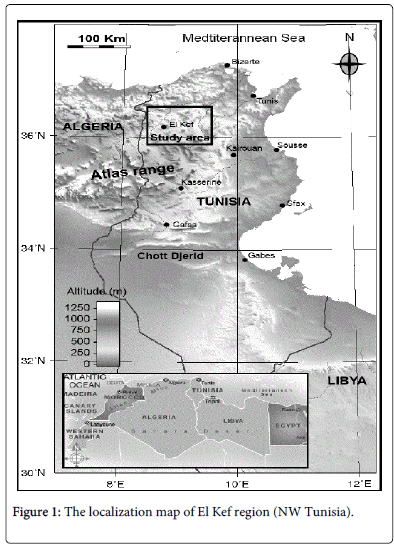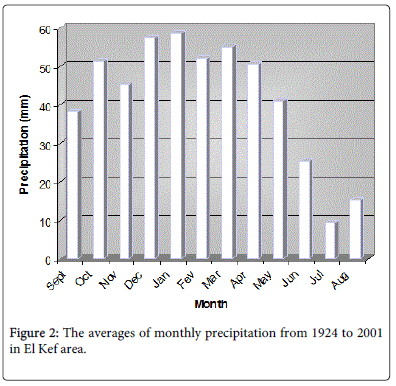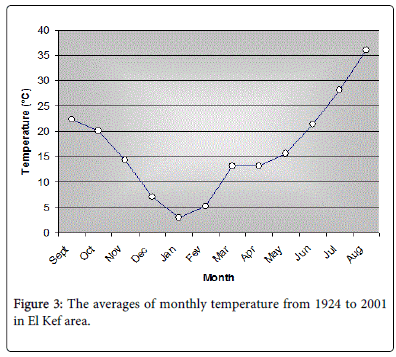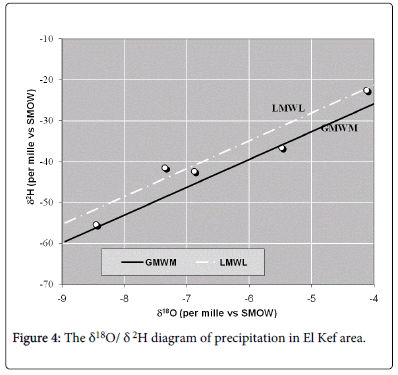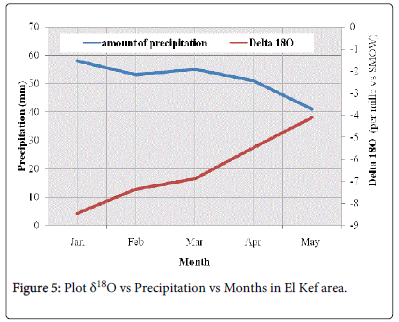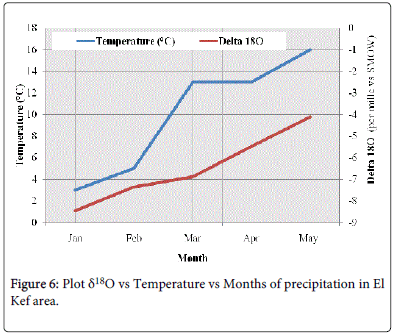Stable Isotope Ratios in Meteoric Waters in El Kef Region, Northwestern Tunisia: Implications for Changes of Moisture Sources
Received: 17-Apr-2014 / Accepted Date: 15-May-2014 / Published Date: 15-Jun-2014 DOI: 10.4172/2157-7617.1000203
Abstract
Natural oxygen and hydrogen stable isotopes (δ18O-H2O and δD-H2O) in modern precipitation collected in five months event in 2001 in Northwestern Tunisia (El Kef area) are presented in this paper. The total correlation between δ18O and δD is obtained as the Global Meteoric Water Line and the Local Meteoric Water Line of the Tunis-Carthage. Seasonal variations of the precipitation D-excess provide more details for changes in moisture sources. The lower δD and δ18O values observed at the El Kef site reflect the combined effects of oceanic and sea vapor sources “Atlantic–Mediterranean origin”, fractionation due to local precipitation, and slower equilibration of the larger raindrops nucleated by a maritime aerosol.
Keywords: Stable isotopes; Precipitation; Vapor sources; Northwestern Tunisia; El kef area
8006Introduction
The stable isotopes 18O(H2O) and 2H(H2O) have many applications in hydrogeological investigations, meteorological, hydrologic, ecological and paleoclimatic studies [1-5]. Due to their high abundance and the simplicity of their analytical determination, spatial and temporal variations in the 18O and 2H contents of precipitation are caused by the isotope fractionation effect accompanying evaporation from the ocean and condensation during the atmospheric transport of water vapor [6,7]. Isotope fractionation is a thermo-dependent reaction, as proved by the existence of a correlation between δ18O in rainwater and environmental temperature [6,8]. Thus, more the temperature is higher; more the heavy isotope is higher. The existence of thermo-dependence in the fractionation of 18O and 2H implies a correlation between the two parameters, which has been defined by different authors:
Craig [9] and Rozanski [10]: Global Meteoric Water Line (GMWL: δ2H=8 δ18O+10);
Zouari [11]: Local Meteoric Water Line of the Tunis-Carthage (LMWL: δ2H=8 δ18O+12.4).
The Global Meteoric Water Line (GMWL) corresponds to the averaging of numerous local meteoric straight lines (regional data), each of which is influenced by the above mentioned geographic and climatic factors. The intercept of the GMWL is termed the deuterium excess (d=δ2H-8 δ18O after Clark [12]. The value of this parameter is acquired during evaporation, and does not vary significantly during the later history of the cloud mass. It is thus a valuable indicator of the source area of the water vapor Rindsberger [13]; Cruz [14]; Celle-Jeanton [15]: d values close to 10% indicate waters of Atlantic origin, values close to 22% are characteristic of waters from the Eastern Mediterranean and d values close to 14%, intermediate between the first 2, are detected in rainwater falling on the Western Mediterranean.
In this study, we report the correlation between δ18O, δD and D-excess value in precipitations and their relationship with temperature. More importantly, their responses to changes in moisture sources will be discussed. This may prove beneficial in understanding the response of precipitation δ18O and δD to climatic/environmental variables in Northwestern Tunisia (El Kef area) and in understanding the palaeoclimatic records associated with precipitation δ18O and δD in monsoon climate studies.
General Setting
Geography
The study area is located in the North Africa and in the NW part of Tunisia, a site located at the southern margin of the Tethys. The El Kef area is located between 40°30′ and 39°45′N, and 6°30′ and 7°30′E, near the Atlantic–Mediterranean confluence (Figure 1). It extends 60 km in the N-S direction and 60-80 km in the E-W direction, covering an area of 420 km2. The elevation of the El Kef Plateau decreases from 400–500 m above sea level (m a.s.l.) (Figure 1).
Climate
Meteorological data (precipitation and temperature) obtained at the nearest meteorological station (El Kef meteorological station: 7G09′00”N, 40G20′70”E, asl 10 m) around the sampling site includes only the period from 1924 to 2001. During this period, the maximum of precipitation was observed in January (58.6 mm) and a minimum in July (9.4 mm) (Figure 2); the maximum and minimum monthly mean temperatures that were recorded was approximately 36°C in August and 3°C in January, respectively (Figure 3). Relative humidity was maximum in spring (˜65%) and minimum in summer (˜26%). Over 80% of the annual precipitation occurs during the rainy season from December to May. The precipitation that occurs during dry season from June to November accounts for about 20%. The potential evapo-transpiration exceeds 1,300 mm [16].
Methods And Sampling
Owing to financial constraints, a limited number of modern meteoric water samples were selected for oxygen-18 and deuterium [16]. Hydrogen and oxygen isotope analyses were performed in the Laboratory of the International Agency of Atomic Energy (IAEA) in Vienna, by employing, respectively the standard CO2 equilibration [17,18] and the zinc reduction techniques [19], followed by analysis on a mass spectrometer. Oxygen and hydrogen isotopes analyses were reported to δ notation relative to Vienna-Standard Mean Oceanic Water (VSMOW), where δ=[(RS/RSMOW)-1] x 1,000; RS represents either the 18O/16O or the 2H/1H ratio of the sample, and RSMOW is 18O/16O or the 2H/1H ratio of the SMOW. Typical precisions are ± 0.1 and ± 1.0% for oxygen-18 and deuterium, respectively. The isotopic composition of oxygen (δ18O) was measured after equilibration with reference CO2 at 25°C for 24 h [17], while reduction on Cr at 800°C was used to determine the isotopic composition of hydrogen (δD) in water [20]. Both measurements were performed on a Varian MAT 250 mass spectrometer.
Precipitation was captured using a dual bucket system in which a smaller bucket with a small hole at the bottom was placed snugly inside a larger bucket. During a rain event, the water drained through the hole, where it would remain inside the larger bucket until sample retrieval. After a snowfall, the sampler was brought inside where the water was melted and drained into the lower bucket. The precipitation samples were then transferred to 5 ml glass vials with poly-seal cone closures. These samples were collected in 1-L Nalgene bottles and then transferred after melting into 5 ml glass vials.
Results And Discussion
Regional isotopic composition of precipitation
The results for meteoric waters are given in Table 1. The isotopic compositions of collected meteoric waters range from -8.45 to -4.12% (δ18O) and -55.40 to -22.60‰ (δ2H) for El Kef area in 2001 [16]. These results are plotted in Figure 6 and in the Table 1. This variation is controlled by local climatic parameters, including the origin of the vapor mass, re-evaporation during rainfall, the seasonality and monthly of precipitation; and suggestive of different atmospheric sources during these months as compared to the other rainy season months of July through September [12,16,21-23]. Generally, the negative precipitation isotopic values are attributed to the air temperature gradient and the massifs that surrounding the study area (Algerian and Tunisian Atlas: “1,000 ≤ altitude ≤ 1,500m”) (Figure 4). One of the factors that can be identified as influential is the distance of the stations from the Ocean and/or the sea.
These negative residuals of the observed δ18O values in precipitation most likely result from strong convective precipitation during the period of Atlantic Ocean monsoon and the Mediterranean Sea activities. Furthermore, positive residuals are observed in the desert area of North Africa by several scientific studies [24-27]. These positive residuals can probably be attributed to the moisture forming precipitation coming from inland vapor cycle. The dry continental air masses usually result in 18O enrichment in precipitation [28,29]. Simultaneously, strong evaporation in these regions also causes raindrops to become increasingly enriched in 18O of precipitation. Additionally, it is noticeable that observed stations of these regions are relatively sparse (Tunis-Carthage and Sfax stations belonging to the GNIP network), which imparts influence on the precision of interpolation results to some extent.
By concerning the amount of precipitation and temperature effects, the values of δ18O and δD in precipitation (Figure 5) decrease with increasing precipitation. At a monthly timescale, the precipitation oxygen isotope composition co-varies with the amount of precipitation “amount effect” (showing negative relationship) and temperature (showing positive relationship) “temperature effect” at the study area (Figure 6). Although a longer time series in Northwestern Tunisia (El Kef basin) would be needed in order to confirm exactly the link of amount of rainfall and temperature with the oxygen isotope composition of precipitation, the available data (only 6 months) and mainly the geological and the climatological regional context support that these variables are direct controls of the isotope signal of precipitation. Over this period, each precipitation event higher than 2 mm (excluding potential precipitation altered by partial evaporation of droplets during fall) was collected and analyzed for deuterium and oxygen-18. The variability of oxygen isotopes in precipitation explained by amount of precipitation (discarding months with upper 40 mm of precipitation) (Table 1).
In other words, the evaporation during passage of raindrops through a warm dry atmosphere typical of semi-arid areas causes a greater enrichment in heavy isotopes in precipitation during small rainfall events than in large rainfall events [6]. This ‘‘amount effect’’ has also been observed in the northern Sahara, where heavy winter rainfalls are generally depleted in heavy isotopes [24,30]. It is also possible that air masses coming from central Europe can contribute to the depletion of isotopic composition (continental effect). The distance between the moisture source and the site of precipitation has been suggested to impact the oxygen isotope composition of precipitation [31,32]. According to the Rayleigh distillation process governing this relationship, the depletion of moisture vapour due to precipitation along the air mass trajectory results in a progressive 18O depletion of the remaining moisture fraction in the atmosphere and the subsequent precipitation events [6,33-37] was the first to recognize that the δD and δ18O composition of precipitation was negatively correlated with temperature, latitude, altitude, distance from the coast, and the amount of precipitation. The change in moisture sources is an important contributor to the precipitation isotope variability [13]. Thus, the paleoclimate oxygen isotope records depending on the isotope composition of precipitation are potentially impacted by moisture sources (continental moisture originates from evaporation of soils, surface waters and plants transpiration), the origin of the precipitation “precipitation from Mediterranean in relation to Atlantic sources, the atmospheric dynamic” [22,23,33,38-41].
The standard diagram of δ18O/ δ2H (Figure 4) shows the position of all samples relative to the Global Meteoric Water Line (GMWL: δ2H=8 δ18O+10) [9,10] and the Local Meteoric Water Line of the Tunis-Carthage (LMWL: δ2H=8 δ18O+12.4) [11] closest to our study area belonging to the GNIP network. This diagram shows that all meteoric water samples lay between the GMWL and the LMWL. This arrangement signifies that the precipitation ensuring the recharge of the El Kef area originates from a mixture of Oceanic and Mediterranean vapor masses. This suggests that the precipitation as the predominant source from the Atlantic (with the intercept +40%) and from the Mediterranean (with the intercept up to +60%) during this period of rain (January to May 2001). However, quantifying the contribution of each of these origins to the total recharge of the basin is difficult, and no simple and reliable methods are currently available. These findings and estimations remain to be developed in the future but with a lot of isotopic data. However, this contribution varies from one period to another and to a geographical area to another; depending on several other parameters (climate, geographical position, storm trajectory, atmospheric moisture, temperature, latitude, altitude, distance from the coast, and the amount of precipitation, also the influence of the isotopic signature of local precipitation “local vapor sources”). The same phenomenon was also observed in the central and southern Tunisia [21,22,42-45]. A mixed isotopic signature of Atlantic and Mediterranean origin was also observed in the karst aquifers of southeastern and south Spain [46,47] and northeastern of Algeria-El Eulma basin [48].
The air passing over El Kef area reflect the combined effects of oceanic-sea vapor sources, fractionation due to local precipitation, and slower equilibration of the larger raindrops nucleated by a maritime aerosol (Mediterranean Sea from the North and from the East). Both larger raindrops as well as the potential for more night-time precipitation [49] may explain the variation isotopic signature of precipitation at El Kef area [23]. Remember, that the observations at this site are based on only half of one year of precipitation data, and additional monitoring may be necessary to confirm the results presented here.
Additionally, the samples that are characterized by a relatively depleted oxygen-18 and deuterium contents, indicate that they are not significantly affected by evaporated. Therefore, the most 18O-enriched value corresponds to rain collected during summer (evaporative influence). This value corresponds to summer precipitation with intense evaporation of the raindrops beneath the cloud base with surface air temperatures around 40°C. The deuterium values are linearly and positively correlated to the δ18O values (Figure 4). The linear correlation was found by many scientists [17,50]. The physical basis for this correlation lies in the fractionation of isotopes during evaporation-condensation processes [51]. This is attributed to the air temperature gradient and the massifs of the country (Tunisian Atlas). One of the factors that can be identified as influential is the distance of the stations from the sea (˜100 km).
Tunisia is located in the Western Mediterranean, which represents a climatic transition zone open to the influence of the cool North Atlantic air masses and the warm Mediterranean air masses [13,43]. Moreover, specific geomorphologic characteristics of Tunisia i.e. the absence of high mountains with elevations exceed 1,500 m and the relatively limited geographic extensions allow the integration of Saharan air masses into the atmospheric circulation [34]. However, hydro-meteorological studies [35,52] suggest the existence of two major trajectories for dominant air masses. These are (i) Atlantic air masses that circulate from the west over Northern Africa and (ii) Mediterranean air masses that come from the north (Figure 1). Quantitatively, Mediterranean precipitation represents ˜66% of the total rainfall. The main part of the regional aquifer recharge is supplied by Mediterranean rain events. The question about how this affects the local precipitation and precipitation δ18O needs future detailed work, for this influence may vary in time and in space.
Deuterium-excess (D-excess) (Table 1), defined as (D-excess=δ2H-8 δ18O), is generally associated with the moisture sources of the precipitation and Sea Surface Temperature (SST; positive correlation) at the moisture source [6,53,54]. It is generally negatively correlated with the relative humidity of the air masses formed above the ocean [53-55], and appears to be used to indicate climatic changes in the moisture source regions [56,57]. Using this relationship, D-excess has been used in many studies to determine the temporal changes in moisture supply for a given location [58]. The average D-excess in El Kef basin during 2001 (from January to May) is 11.94‰. The d values, varying from 7.24‰ (April) to 17.3‰ (February). The high D-excess for the winter samples indicating evaporation in low humidity conditions and low D-excess in summer (coupled with the higher δ18O) indicating the possible re-evaporation below the cloud.
| Date | Amount of precipitation | Temperature (°C) | Delta 18O | Delta 2H | D-excess |
|---|---|---|---|---|---|
| January 2001 | 58 | 3 | -8.45 | -55.4 | 12.2 |
| February 2001 | 53 | 5 | -7.35 | -41.5 | 17.3 |
| March 2001 | 55 | 13 | -6.88 | -42.4 | 12.64 |
| April 2001 | 51 | 13 | -5.48 | -36.6 | 7.24 |
| May 2001 | 41 | 16 | -4.12 | -22.6 | 10.36 |
Table 1: Isotopic data for the precipitation in El Kef area (2001). (Delta 18O and 2H: per mille VSMOW “Vienna-Standard Mean Ocean Water”)- Precipitation (mm)
These results indicate a larger proportion of local moisture for the precipitation in 2001 in northwestern Tunisia. To improve the quality of this moderate interpretation, probably we should adopt a model analysis on trajectory of air-mass with combination with several isotopic analyses. Moreover, like several scientific authors in the word, I hope that application of these isotopic and modeling methods (GIS) would become of common use in order to advance in our knowledge of the oxygen, deuterium isotopes and D-excess composition at different areas in the word and to improve and facilitate the interpretations of paleoclimate depending on it and with the inter-discipline inter-collaboration.
Conclusions
Isotopic composition of precipitation in semi-arid northwestern Tunisia (El Kef area) is highly variable and barely seasonally controlled. This variability is at least in part explained by different pathways of the rain-bringing air masses. We were able to show that air masses coming from southern and western directions in general have significantly lower “d” values than rains from northern and eastern directions due to rainout effects of air-masses. Evaporation effects dominate the isotopic composition of many rainfall events with less than 2 mm, as indicated by their low “d” values.
The relationship between δ2H and δ18O for local precipitation in El Kef region shows that precipitation originating from cold and wet to hot and dry and the differing contribution of vapor derived from the closed marine basin of the Mediterranean Sea and the Atlantic Ocean vapor source that contains a maritime aerosol. However, in Tunisia geographical diversity influences the complicated mixing of continental and maritime air masses and the sources of air masses even change during a rain event. A mixed isotopic signature of Atlantic and Mediterranean origin was also observed in the aquifers of south Tunisia, Algeria, Morocco and Spain [21,22,47,59-61]. In reality, this seasonal variability of δ18O and δD values apparent in precipitation in the El Kef area is likely to be reflected in the isotopic composition of the surface waters and the ground waters [23].
Acknowledgements
The author is thankful to the Editor and the anonymous reviewers for their valuable suggestions and would like to thank the International Agency of Atomic Energy (IAEA) for financial support to carry out this work, to the Radio-Anlaysis Laboratory of the National School of Engineers of Sfax and to the Water, Energy and Environmental Laboratory (L3E)-ENIS-Sfax-Tunisia. Special thanks are directed to the staff members of El Kef Water Resources Division/Agriculture Ministry. The author should like also to thank sincerely the numerous people who helped me in the preparation of this paper.
References
- Gat JR (1971) Comments on the stable isotope method in regional groundwater investigations. Water Resour Res 7: 980-993.
- Lee KS, Wenner DB, Lee I (1999) Using H- and O-isotopic data for estimating the relative contributions of rainy and dry season precipitation to groundwater: example from Cheju Island, Korea. J Hydrol 222: 65-74.
- Hoefs J (2004) Stable Isotope Geochemistry, (5th edn.). Springer, Berlin, Germany.
- Price RM, Swart PK (2006) Geochemical indicators of groundwater recharge in the Surficial Aquifer System, Everglades National Park, Florida, USA. Geological Society of America 404: 251-266.
- Scholl MA, Ingebritsen SE, Janik CJ, Kauahikaua JP (1998) Use of precipitation and groundwater isotopes to interpret regional hydrology on a tropical volcanic island; Kilauea volcano area, Hawaii. Water Resour Res 32: 3525-3537 .
- Dansgaard W (1964) Stable isotopes in precipitation. Tellus 16: 436-468.
- Gat I, Gonfiantini R (1981) Stable isotope hydrology: deutenium and oxygen-l8 in the water cycle. IAEA Rep Ser 210: 1-339.
- Siegenthaler V, Oeschger H (1980) 18O in precipitation: correlation with temperature and altitude on a regional scale. Nature 285: 314-316.
- Craig H (1961) Isotopic Variations in Meteoric Waters. Science 133: 1702-1703.
- Rozanski K, Araguàs L, Gontantini R (1993) Isotopic patterns in modern global precipitation. In: Continental Isotope Indicators of Climate. American Geophysical Union, USA.
- Zouari K, Aranyossy JF, Mamou A, Fontes JC (1985) Etude isotopique et géochimique des mouvements et de l’évolution des solutions de la zone aérée des sols sous climat semi-aride (Sudtunisien). IAEA, Vienna.
- Clark ID, Fritz P (1997) Environmental isotopes in hydrogeology. Lewis Publishers, New York, USA.
- Rindsberger M, Magaritz M, Carmi I, Gilad D (1983) The relation between air mass trajectories and the water isotope composition in the Mediterranean Sea area. Geophys Rev Lett 10: 43-46.
- Cruz-Sanjulià n J, Araguàs L, Rozanski K, Cardenal J, Hidalgo MC, et al. (1992) Sources of precipitation over South-Eastern Spain and groundwater recharge. An isotopic study. Tellus 44: 226-236.
- Celle H, Zouari K, Travi Y, Daoud A (2001) Caractérisationisotopique des pluies en TunisieEssai de typologiedans la région de Sfax. C R AcadSci Paris 6: 625-631.
- Hamed Y (2004) Caractérisationhydrogéologique, hydrochimique et isotopique des eauxsouterraines de la région du Kef (Nord OuestTunisien). Mémoire DEA, Faculté des Sciences de Sfax.
- Epstein S, Mayeda TK (1953) Variations of 18O content of waters from natural sources. GeochimCosmochimActa 4: 213-224.
- Swart PK (2000) The oxygen isotopic composition of interstitial waters: evidence for fluid flow and recrystallization in the margin of the Great Bahama Bank. Scientific Results 166: 91-98.
- Coleman ML, Sheperd TJ, Durham JJ, Rouse JE, Moore GR (1982) Reduction of water with zinc for hydrogen isotope analysis. Anal Chem 54: 993-995.
- Gehre M, Hoefling R, Kowski P, Strauch G (1996) Sample preparation device for quantitative hydrogen isotope analysis using chromium metal. Anal Chem 68: 4414-4417.
- Hamed Y, Zairi M, Ali W, Ben DH (2010) Estimation of residence times and recharge area of groundwater in the Moulares mining basin by using carbon and oxygen isotopes (South Western Tunisia). J Environ Protect 1: 466-474.
- Hamed Y, Dassi L, Tarki M, Ahmadi R, Mehdi K, et al. (2010) Groundwater origins and mixing pattern in the multilayer aquifer system of the Gafsa-south mining district: a chemical and isotopic approach. Environ Earth Sci 63: 1355-1368.
- Hamed Y, Dhahri F (2013) Hydro-geochemical and isotopic composition of groundwater and meteoric water, with emphasis on sources of salinity, in the aquifer system in Northwestern Tunisia. J Afr Earth Sci 83: 10-24.
- Fontes JC (1980) Environmental isotopes in groundwater hydrology. In: Fritz P, Fontes JC (eds) Handbook of environmental isotope geochemistry. Elseiver, Amsterdam, Germany.
- Awad MA (1996) Application of stable isotopes (18O, D) and geochemistry to study groundwater in Bahareya Oasis, Western Desert. Egypt. Isot Environ Health Stud 32: 87-95.
- Gat RJ, Klein B, Kushnir Y, Roether W, Wernli H, et al. (2003) Isotope composition of air moisture over the Mediterranean Sea: an index of the air-sea interaction pattern. Tellus B 55: 953-965.
- International Atomic Energy Agency (2005) Isotopic Composition of Precipitation in the Mediterranean Basin in Relation to Air Circulation Patterns and Climate. IAEA, Vienna.
- Araguaas-Araguaás L, Froehlich K, Rozanski K (1998) Stable isotope composition of precipitation over Southeast Asia. J Geophy Res 103: 28721-28742.
- Tian L, Yao T, MacClune K, White JW, Schilla A, et al. (2007) Stable isotopic variations in west China: a consideration of moisture sources. J Geophy Res 112: D10.
- Gasse F (2002) Diatom-inferred salinity and carbonate oxygen isotopes in Holocene waterbodies of the Western Sahara and Sahel (Africa). QuaternSci Rev 21: 737-767.
- Aggarwal PK, Fröhlich K, Kulkarni KM, Gourcy LL (2004) Stable isotope evidence for moisture sources in the Asian summer monsoon under present and past climate regimes. Geophys Res Lett 31: L08203.
- Breitenbach SF, Adkins JF, Meyer JF, Marwan N, Krishna KK, et al. (2010) Strong influence of water vapour source dynamics on stable isotopes in precipitation observed in southern Meghalaya, NE India. Earth Planet SciLett 292: 212-220.
- Charles CD, Rind D, Jouzel J, Koster RD, Fairbanks RG (1994) Glacial-interglacial changes in moisture sources for greenland: influences on the ice core record of climate. Science 263: 508-511.
- Celle-Jeanton H, Travi Y, Blavoux B (2001) Isotopic typology of the precipitation in the Western Mediterranean region at three different time scales. Geophys Res Lett 28: 1215-1218.
- Celle-Jeanton H, Zouari K, Travi Y, Daoud A (2001) Caractérisationisotopique des pluies en Tunisie. Essai de typologiedans la région de Sfax. C R AcadSci Paris 333: 625-631.
- Carreira PM, Araujo MF, Nunes D (2005) Isotopic composition of rain and water vapour samples from Lisbon region: characterization of monthly and daily events. IAEA Tecdoc 1453: 141-155.
- Krklec K, Dominguez-Villar D (2014) Quantification of the impact of moisture source regions on the oxygen isotope composition of precipitation over Eagle Cave, central Spain. Geochimica et CosmochimicaActa 134: 39-54.
- Stute M, Talma AS (1998) Glacial temperatures and moisture transport regimes reconstructed from noble gasses and d18O, Stampriet aquifer, Namibia. In Isotope Techniques in the Study of Environmental Change. IAEA publications, Viena.
- Sodemann H, Schwierz C, Wernli H (2008) Interannual variability of Greenland winter precipitation sources: Lagrangian moisture diagnostic and North Atlantic Oscillation influence. J Geophys Res 113: D03107.
- Sjostrom DJ, Welker JM (2009) The influence of air mass source on the seasonal isotopic composition of precipitation, eastern USA. J GeochemExplor 102: 103-112.
- Hamed Y (2012) Monthly isotopes (d18O and dD) variations of meteoric waters in El Kef region, Northwestern Tunisia. International colloque Annaba, Algeria.
- Kamel S, Dassi L, Zouari K, Abidi B (2005) Geochemical and isotopic investigation of the aquifer system in the Djerid-Nefzaoua basin, southern Tunisia. Environ Geol 49: 159-170.
- Hamed Y (2011) The hydrogeochemical characterization of groundwater in Gafsa-SidiBoubaker region (Southwestern Tunisia). Arab J Geosci 6: 697-710.
- Abid K, Hadj AF, Chkir N, Zouari K (2011) Relationship between Senonian and deep aquifers in Southern Tunisia. QuatInt 257: 13-26.
- Jeribi DL, Zouari K, Michelot JL (2012) Recharge and paleorecharge of the deep groundwater aquifer system in the Zeroud Basin (Kairouan plain, Central Tunisia). QuatInt 257: 56-63.
- Vandenschrick G, Van WB, Frot E, Pulido-Bosch A, Molina L, et al. (2002) Using stable isotope analysis (dD-d18O) to characterize the regional hydrology of the Sierra de Gador, south east Spain. J Hydrol 265: 43-55.
- Andreo B, Linan C, Carrasco F, Jimenez de Cisneros C, Caballero F, et al. (2004) Influence of rainfall quantity on the isotopic composition (18O and 2H) of water in mountainous areas. Application for groundwater research in the Yunquera-Nieves karst aquifers (S Spain). ApplGeochem 19: 561-574.
- Demdoum A (1996) Étudehydrogéologique de la plained’ElEulma et le problème de la qualité des eaux, Thèse; Magister, Uni Constantine.
- Yang S, Smith EA (2006) Mechanisms for diurnal variability of global tropical precipitation observed from TRMM. J Clim 19: 5190-5226.
- Friedman I (1953) Deuterium content of natural waters and other substances. GeochimCosmochimActa 4: 83-103.
- Gourcy LL, Groening M, Aggrawal PK (2005) Stable oxygen and hydrogen isotopes in precipitation. In: Aggarwal, P.K., Gat, J.R., Froehlich, K.F.O. (Eds.), Isotopes in the Water Cycle 39-51.
- Celle H (2000) Caractérisation des précipitationssur le pourtour de la Méditerranéeoccidentale: Approcheisotopique et chimique. Thèse de 3éme cycle Univ Avignon Pays Vaucluse 222.
- Merlivat L, Jouzel J (1979) Global climate interpretation of the deuterium-oxygen 18 relationship for precipitation. J Geophys Res 84: 5029-5033.
- Uemura R, Matsui Y, Yoshimura K, Motoyama H, Yoshida N (2008) Evidence of deuterium excess in water vapor as an indicator of ocean surface conditions. J Geophys Res 113: D19114.
- Pfahl S, Wernli, H (2008) Air parcel trajectory analysis of stable isotopes in water vapor in the eastern Mediterranean. J Geophys Res 113: D20104.
- Petit JR, White JC, Young NW, Jouzel J, Korotkevich YS (1991) Deuterium excess in recent antarctic snow. J Geophys Res 96: 5113-5122.
- Masson-Delmotte V1, Jouzel J, Landais A, Stievenard M, Johnsen SJ, et al. (2005) GRIP deuterium excess reveals rapid and orbital-scale changes in Greenland moisture origin. Science 309: 118-121.
- Vimeux F, Masson V, Jouzel J, Petit JR, Steig EJ, et al. (2001) Holocene hydrological cycle changes in the Southern Hemisphere documented in East Antarctic deuterium excess records. ClimDyn 17: 503-513.
- Winckela A, Marlina C, Devera L, Morelb JL, Morabitic K, et al. (2002) Apport des isotopes stables dansl’estimation des altitudes de recharge de sources thermales du Maroc. C R Geosci 334: 469-474.
- Moulla AS, Guendouz A (2003) Étude des ressources en eau souterraines en zones arides (Sahara Algérien) par les méthodesisotopiques. International Association of Hydrological Sciences 35-42.
- Abid K, Trabelsi R, Zouari K, Abidi B (2009) Caractérisationhydrogéochimique de la nappe du Continental Intercalaire (SudTunisien)/Hydrogeochemical characterization of the Continental Intercalaire aquifer (southern Tunisia). J SciHydrol 54: 526-537.
Citation: Hamed Y (2014) Stable Isotope Ratios in Meteoric Waters in El Kef Region, Northwestern Tunisia: Implications for Changes of Moisture Sources. J Earth Sci Clim Change 5: 203. DOI: 10.4172/2157-7617.1000203
Copyright: © 2014 Hamed Y. This is an open-access article distributed under the terms of the Creative Commons Attribution License, which permits unrestricted use, distribution, and reproduction in any medium, provided the original author and source are credited.
Share This Article
Recommended Journals
Open Access Journals
Article Tools
Article Usage
- Total views: 15430
- [From(publication date): 8-2014 - Apr 03, 2025]
- Breakdown by view type
- HTML page views: 10844
- PDF downloads: 4586

